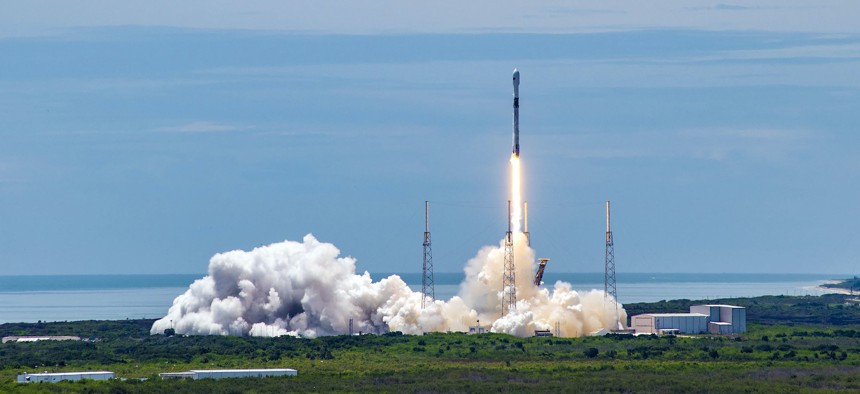
Falcon 9 launches the GPS III Space Vehicle 05 mission from Space Launch Complex 40 at Cape Canaveral Space Force Station, Florida, June 17, 2021. U.S. Space Force / Staff Sgt. Jeremy Mosier
Space Force to Spend $340 Million on New Training Infrastructure
The service’s budget proposal also includes $99 million in the next year for updated space launch ranges, and $1 billion more across the next five years.
The Space Force wants hundreds of millions of dollars to train its guardians to defend its space architecture.
Out of its $30 billion 2024 spending request, about $340 million would go to building Space Force’s operational testing and training infrastructure, Chief of Space Operations Gen. Chance Saltzman said Tuesday during a Senate Armed Services Committee hearing.
Saltzman has said he wants a training infrastructure that can prepare guardians for a wide variety of threats, rather than focusing on one particular scenario or competitor. The operational testing and training infrastructure, or OTTI, will include simulators, ranges, testing equipment, and digital engineering efforts, among other things, he told reporters in a media roundtable in late January.
On Tuesday, the general said he’s “really comfortable” with spending $340 million on training “because we've got a lot of studying to do to make sure we're building the right kind of ranges, the right kind of simulators, and we're learning as we go a little bit.”
About 65 percent of the force’s 2024 budget will go to research and development, which Saltzman said is necessary as the “nature” of space business is less focused on procurement.
Cost projections for the Space Force over the next five years are “reasonable,” Air Force Secretary Frank Kendall told reporters Friday, ahead of Monday's budget rollout, but noted that there’s some “uncertainty about what follows the research and development” and how the service will realize its next-generation capabilities.
Saltzman also continued to stress the importance of proliferated low Earth orbit satellites, which have been proven to be a “much tougher target” for Russia during the war in Ukraine.
“By going to low Earth orbit, we're buying smaller satellites and more of them. More satellites creates a targeting problem,” Saltzman said.
Funding for the Next-Gen OPIR missile warning program—the Next Generation Overhead Persistent Infrared constellation—declined this year, as Saltzman said the Space Force is cutting its third geosynchronous satellite.
Instead, the department will pursue a “two-by-two” constellation—two GEO and two polar satellites, Saltzman said.
“GEO satellites are too much of a target, so having them in lower- to middle-Earth orbit creates a targeting problem for an adversary, which actually lowers the threshold for attack on orbit. It's more resilient and it creates a level of deterrence because they can't attack the satellites,” Saltzman said.
The budget also begins funding the service’s long-discussed “updated space launch range of the future” with $99 million in fiscal 2024 and “over a billion dollars” across the future years defense program, Saltzman said Wednesday at the annual McAleese conference.
“Developing innovative commercial launch technology ensures the U.S. outpaces global competitors and supports an accelerating domestic space launch market. In doing so, we maintain safe and assured launch for commercial, civil, and Department of Defense users,” he said.
To take advantage of industry’s success in space, the Space Force is developing a “commercial augmentation space reserve,” similar to the Air Force’s Civil Reserve Air Fleet, or CRAF, Saltzman said. CRAF takes commercial aircraft from U.S. airlines to join DOD in a time of emergency.
Augmenting commercial services—such as satellite communications, space domain awareness, intelligence, surveillance, and reconnaissance—for military use has been successful in conflict, Saltzman said. For example, Elon Musk’s Starlink has been a linchpin in the Ukrainian force’s kill chain.
“We're working through policy considerations, contractual considerations, legal considerations, to figure out how we employ them ahead of time. We think about this ahead of time, so that we're not trying to do this on the fly during a crisis,” Saltzman said.




